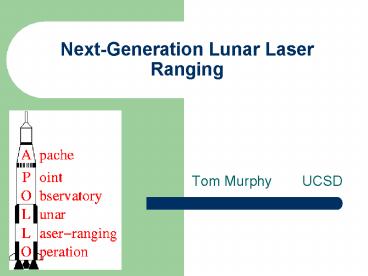NextGeneration Lunar Laser Ranging - PowerPoint PPT Presentation
1 / 20
Title:
NextGeneration Lunar Laser Ranging
Description:
Make test bodies large. Gravity dominates ... Geodetic precession ( ) to 3 10-4. Long range forces to 10-11 the strength of gravity ... – PowerPoint PPT presentation
Number of Views:53
Avg rating:3.0/5.0
Title: NextGeneration Lunar Laser Ranging
1
Next-Generation Lunar Laser Ranging
- Tom Murphy UCSD
2
Designing the Perfect Gravity Test
- Gravity must be the dominant influence
- Negligible frictional, electrostatic, radiation
forces - Make test bodies large
- Gravity dominates
- Test Strong Equivalence Principle (SEP) by having
appreciable self-energy how does gravity pull
on gravity? - Place in vacuum environment
3
Precision Requirements
- Order-of-Magnitude improvement over current
measurements/tests of gravity - 10-5 test of General Relativity
- 10-14 measurement precision needed
- Good clocks are 10-12
- Need leverage somehow
4
Earth-Moon System Fits the Bill
- Earth self-energy is 0.510-9 of total mass
- Moon is large, but only 0.0210-9 in grav. energy
- Non-gravitational forces very small
- Self-energy small compared to that of earth
- Sun dominates for both bodies
- Can test differential motion/acceleration to Sun
- Leverage from proximity of moon to earth
- Rearth-moon 1/400 A.U. ? test motion with
respect to sun at 1 A.U. via much shorter
(differential) measurement
5
Historical Accuracy of Lunar Ranging
Weighted RMS Residual (cm)
6
Current PPN Constraints on GR
Is the Parameterized Post-Newtonian (PPN)
formalism still relevant?
- Basic phenomenology
- measures curvature of
- spacetime, ? measures
- nonlinearity of gravity
What fool would want to push this further?
Isnt GR obviously right?
7
Why Push Further Aristotelian Analogy
Einsteinian Departures at 10-8 level of precision
8
Real Rationale for Pushing Further
- Gravity is incompatible with the Standard Model
- Cosmological departures from old GR model
- Acceleration of expansion of Universe
- Fine structure constant, ?, possibly varying?
- What about gravitational constant, Equivalence
Principle - Scalar Field modifications to GR
- Predictions of PPN departures from GR
- Brane-world cosmological models
- Gravitons leaking into bulk, modifying gravity at
large scales
9
APOLLO Next-Generation LLRrecipe for success
- Move LLR back to a large-aperture telescope
- 3.5-meter more photons!
- Incorporate modern technology
- Detectors, precision timing, laser
- Re-couple data collection to analysis/science
- Scientific enthusiasm drives progress
- Devise brilliant acronym
- Apache Point Observatory Lunar Laser-ranging
Operation
10
APOLLO Goals
- One millimeter range precision
- Weak Equivalence Principle (WEP) to ?a/a 10-14
- Strong Equivalence Principle (SEP) to ? 310-5
- Gravitomegnetism (frame dragging) to 10-4
- dG/dt to 10-13G per year
- Geodetic precession (? ?) to 310-4
- Long range forces to 10-11 the strength of
gravity
These 1? errors are simply 10 times better
than current LLR limits. In each case, LLR
currently provides the best limits. Timescales to
achieve stated results vary according to the
nature of the signal.
11
The APOLLO Apparatus
- Uses 3.5-meter telescope at 9200-ft Apache Point,
NM - Excellent atmospheric seeing
- 532 nm NdYAG, 100 ps, 115 mJ/pulse, 20 Hz laser
- Integrated avalanche photodiode (APD) arrays
- Multi-photon capability
- Daylight/full-moon capability
12
APD Arrays
- We have a working prototype courtesy MIT Lincoln
Labs - 44 format (LL has made much larger)
- 30?m diameters on 100?m centers
- Fill-factor recovered by lenslet array
- 30 ps jitter at 532 nm, 50 photon detection
eff. - Multiple buckets for photon bundle
13
Millimeter Range?!!
- Seven picosecond round-trip travel time error
- Half-meter lunar reflectors at 7 tilt ? up to
35 mm RMS uncertainty per photon - 95 ps FWHM laser pulse ? 6 mm RMS
- Need 402 1600 photons to beat down error
- Calculate 5 photon/pulse return for APOLLO
- Realistic 1 photon/pulse ? 20 photons/sec ?
millimeter statistics achieved on few-minute
timescales
14
APOLLO Random Error Budget
15
APOLLO Systematic Errors
- Various contributions to systematic error
- Atmospheric refractive delay (2-meter signal)
- Ocean, atmosphere, and ground-water loading
- Thermal expansion of telescope reflectors
- Will implement supplemental metrology on-site
- Barometric transducer array
- Superconducting gravimeter (lt1 mm vertical
displacements) - Precision GPS (0.5 mm horz., 2.3 mm vert. in 24
hr) - IMPORTANT Science signals are narrow-band
- Environmental factors will not mimic new physics
16
Laser Mounted on Telescope
Mounted June 2003
In thermal enclosure (fridge)
17
Timing Electronics Built/Verified
Timing System in Operation
CAMAC Crate Inhabitants
Calibration/Frequency Board
APOLLO Command Module Timing/APD control, CPU
interface
18
(No Transcript)
19
Future Laser Ranging Tests of GR
- Interplanetary is next logical step
- Laser transponder on Mars measures ? to 410-6,
and ? to 10-5 - Mercury orbiter (Messenger launched) could be
used to measure perihelion shift ? ? - May perform test-ranging from Apache Point this
summer - LATOR (stay tuned for Turyshev talk) uses
inter-spacecraft laser ranging to measure
curvature of spacetime to unprecedented
precision ? to 10-8
20
APOLLO Collaboration
UCSD Tom Murphy John Goodkind Eric Michelsen U.
Washington Eric Adelberger Jana Strasburg Larry
Carey Northwest Analysis Ken Nordtvedt
JPL Jim Williams Jean Dickey Slava
Turyshev Lincoln Labs Brian Aull Bernie
Kosicki Bob Reich Harvard Chris Stubbs
Joint NASA/NSF funding































